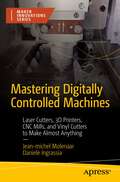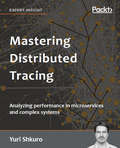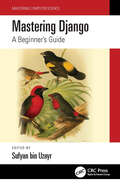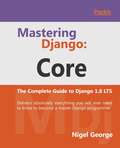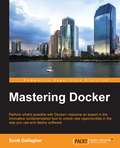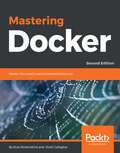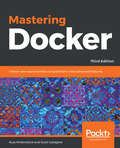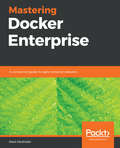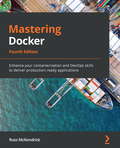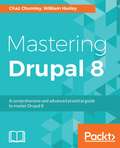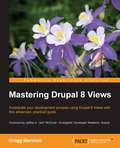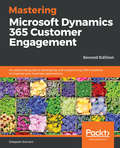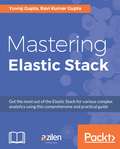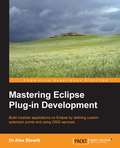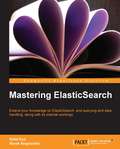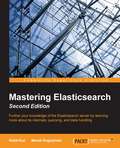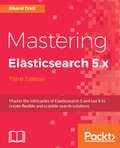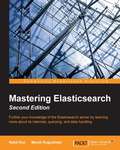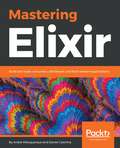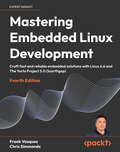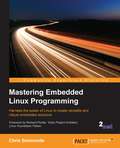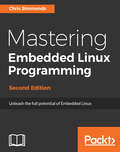- Table View
- List View
Mastering Digitally Controlled Machines: Laser Cutters, 3D Printers, CNC Mills, and Vinyl Cutters to Make Almost Anything (Maker Innovations Series)
by Daniele Ingrassia Jean-michel MolenaarTake control of your machine building and production processes with computer-run tools to safely use, or even build, a durable machine for use in your garage or even a startup company. This book provides best practices for laser cutters, 3D printers, CNC mills, vinyl cutters, and more. You'll begin by learning the history of digitally controlled tools, as well as how they work and what materials you can use with them. With this knowledge, you won’t just learn how to make common machines work, you’ll go to the next level and build your own machine—whether that be a plasma cutter or a CNC milling machine.You will learn how they use these tools to create amazing products, art, and even new machines! You’ll also find handy overviews of tools, software, and materials to use in a reference appendix. After reading Mastering Digitally Controlled Machines you’ll be able to create something for yourself, your community, or your company.What You'll LearnUse accessible computer-controlled machines safely to make anything you want to buildFit the right tool and materials with the right projectsBuild your own CNC machine custom tailored to your project’s needs Who This Book Is ForPeople who want to understand how accessible computer-controlled tools work and build any kind of product themselves. Makerspaces, Fab Labs, and similar spaces will benefit. And people who want to create prototypes and products for themselves or their company/ startup, or to start creating prototypes without much prior knowledge.
Mastering Distributed Tracing
by Yuri ShkuroAny developer interested in testing large systems will find this book very revealing and in places, surprising. Every microservice architect and developer should have an insight into distributed tracing, and the book will help them on their way. System administrators with some development skills will also benefit. No particular programming language skills are required, although an ability to read Java, while non-essential, will help with the core chapters.
Mastering Django: A Beginner's Guide (Mastering Computer Science)
by Sufyan Bin UzayrMastering Django helps the reader master the powerful Django framework for Python for creating dynamic applications and projects. Django is a high-level, open-source Python web framework created to help web developers achieve tight deadlines while also meeting a variety of needs. The primary feature of Django that makes it so popular among developers is that it promotes rapid development while providing a consistent and realistic design. Django is a complete toolkit with a basic code architecture and highly adaptable architecture that promotes rapid development — it can shape and pace your web app concept and see it through to launch in a matter of hours. Django's simplicity, stability, scalability, and flexibility are unmatched. It is currently a vibrant, collaborative open source project with thousands of users and contributors. Django is a versatile framework capable of developing any website. Robust design, rapid software development, fantastic documentation and tutorials, a vast community with readymade solutions,reasonably easy learning curve, and a high degree of clarity and readability are all hallmarks of this popular web framework. Django has carved out a niche for itself in the industry over the years, and appropriately so. Many popular apps use Django as their secret ingredient. Django has many faetures and can accommodate any modern web application. If you wish to build a successful career in web development, learning Django is a wise choice. With Mastering Django, learning the Django framework becomes a charm, and will help readers undoubtedly advance their careers. About the Series The Mastering Computer Science covers a wide range of topics, spanning programming languages as well as modern-day technologies and frameworks. The series has a special focus on beginner-level content, and is presented in an easy to understand manner, comprising: Crystal-clear text, spanning various topics sorted by relevance, Special focus on practical exercises, with numerous code samples and programs, A guided approach to programming, with step by step tutorials for the absolute beginners, Keen emphasis on real-world utility of skills, thereby cutting the redundant and seldom-used concepts and focusing instead of industry-prevalent coding paradigm, A wide range of references and resources, to help both beginner and intermediate-level developers gain the most out of the books. Mastering Computer Science series of books start from the core concepts, and then quickly move on to industry-standard coding practices, to help learners gain efficient and crucial skills in as little time as possible. The books assume no prior knowledge of coding, so even the absolute newbie coders can benefit from this series. Mastering Computer Science series is edited by Sufyan bin Uzayr, a writer and educator with over a decade of experience in the computing field.
Mastering Django: Core
by Nigel GeorgeDelivers absolutely everything you will ever need to know to become a master Django programmer About This Book • Gain a complete understanding of Django—the most popular, Python-based web framework in the world • Gain the skills to successfully designing, developing, and deploying your app • This book is packaged with fully described code so you can learn the fundamentals and the advanced topics to get a complete understanding of all of Django's core functions Who This Book Is For This book assumes you have a basic understanding of the Internet and programming. Experience with Python or Django would be an advantage, but is not necessary. It is ideal for beginner to intermediate programmers looking for a fast, secure, scalable, and maintainable alternative web development platform to those based on PHP, Java, and dotNET. What You Will Learn • Use Django to access user-submitted form data, validate it, and work with it • Get to know advanced URLconf tips and tricks • Extend Django's template system with custom code • Define models and use the database API to create, retrieve, update, and delete records • Fully extend and customize the default implementation as per your project's needs • Test and deploy your Django application • Get to know more about Django's session, cache Framework, and middleware In Detail Mastering Django: Core is a completely revised and updated version of the original Django Book, written by Adrian Holovaty and Jacob Kaplan-Moss - the creators of Django. The main goal of this book is to make you a Django expert. By reading this book, you'll learn the skills needed to develop powerful websites quickly, with code that is clean and easy to maintain. This book is also a programmer's manual that provides complete coverage of the current Long Term Support (LTS) version of Django. For developers creating applications for commercial and business critical deployments, Mastering Django: Core provides a complete, up-to-date resource for Django 1.8LTS with a stable code-base, security fixes and support out to 2018. Style and approach This comprehensive step-by-step practical guide offers a thorough understanding of all the web development concepts related to Django. In addition to explaining the features of Django, this book provides real-world experience on how these features fit together to build extraordinary apps.
Mastering Docker
by Scott GallagherRethink what's possible with Docker - become an expert in the innovative containerization tool to unlock new opportunities in the way you use and deploy softwareAbout This BookCreate highly scalable applications and services using the Linux container virtualization paradigmExtend Docker with external platforms, including Heroku and OpenStackIntegrate with some of the most innovative and exciting orchestration tools such as Kubernetes for larger and more controlled deploymentsWho This Book Is ForIf you recognize Docker's importance for innovation in everything from system administration to web development, but aren't sure how to use it to its full potential, this book is for you.What You Will LearnBecome fluent with the basic components of DockerLearn best practices for storing and managing Docker filesSecure your containers and files with Docker's security featuresLearn how to use Docker machine to build new servers from scratchFind out how to set up and manage multiple environments with Docker composeUtilize Docker Swarm to orchestrate containers across different serversIntegrate Docker with a wide range of cloud and configuration tools to fully realize its potentialIn DetailDocker has been a game-changer when it comes to virtualization - it has now grown to become a key driver of innovation beyond system administration, having an impact on the world of web development and more. But how can you make sure you're keeping up with the innovations that it's driving? How can you be sure you're using it to its full potential? Mastering Docker shows you how - it not only demonstrates how to use Docker more effectively, it also helps you rethink and reimagine what's possible with Docker.Covering best practices to make sure you're confident with and the basics, such as building, managing and storing containers, before diving deeper into Docker security, you'll find everything you need to help you extend and integrate Docker in new and innovative ways. You'll learn how to take greater control over your containers using some of Docker's most sophisticated and useful tools, such as Docker compose and Docker swarm, before bringing together everything you already know and have learned to put your containers into production and monitor them for safety and performance.Beyond this, you'll also explore even more advanced strategies, as you learn how to extend and integrate Docker with cloud platforms such as Heroku and OpenStack, and how tools such as Kubernetes can improve the way you manage large-scale container orchestration. With further guidance on how you can use configuration management tools such as Puppet, Chef and PowerShell, by the end of the book you'll have a broad and detailed sense of exactly what's possible with Docker - and how seamlessly it fits with a range of other platforms and tools.Style and approachThis book takes you through some of the most sophisticated Docker tools in a way that's accessible and practical. It has been created to help you put new ideas in practice - and to demonstrate precisely what's possible with Docker.
Mastering Docker - Second Edition: Unlock New Opportunities Using Docker's Most Advanced Features, 3rd Edition
by Russ Mckendrick Scott GallagherUnlock new opportunities using Docker's most advanced features. About This Book • Experience first- and third-party tools such as Docker Compose, Docker Machine, Portainer, and Rancher • Learn how to leverage Kubernetes, Amazon ECS, and Docker Swarm and know when each solution is appropriate • Discover how Docker can be integrated into your daily workflows Who This Book Is For If you are an I.T Professional and recognize Docker's importance for innovation in everything from system administration to web development, but aren't sure how to use it to its full potential, this book is for you. What You Will Learn • Become fluent in the basic components and concepts of Docker • Secure your containers and files with Docker's security features • Extend Docker and solve architectural problems using first- and third-party orchestration tools, service discovery, and plugins • Leverage the Linux container virtualization paradigm by creating highly scalable applications In Detail Docker has been a game-changer when it comes to how modern applications are deployed and architectured. It has now grown into a key driver of innovation beyond system administration, with an impact on the world of web development and more. But how can you make sure you're keeping up with the innovations it's driving This book shows you how; it not only demonstrates how to use Docker more effectively, it also helps you rethink and reimagine what's possible with Docker. You will also cover basic topics such as building, managing and storing images along with best practices to make you confident before delving more deeply into Docker security. You'll find everything related to extending and integrating Docker in new and innovative ways. Docker Swarm and Docker Compose will help you take control of your containers in an efficient way. By the end of the book, you will have a broad and detailed sense of exactly what's possible with Docker and how seamlessly it fits in with a range of other platforms and tools. Style and approach A clear, concise, and straightforward book to make you a Master in Docker by including topics such as extending and integrating Docker along with different Docker tools, in a way that's accessible and practical. This book has been created to help you put new ideas into practice, and to demonstrate precisely what's possible with Docker.
Mastering Docker - Third Edition: Unlock new opportunities using Docker's most advanced features, 3rd Edition
by Scott Gallagher Russ McKendrickIf you are an I.T professional and recognize Docker's importance for innovation in everything from system administration to web development, but aren't sure how to use it to its full potential, Mastering Docker is for you.
Mastering Docker Enterprise: A companion guide for agile container adoption
by Mark PanthoferA journey toward containerized applications in production with a cloud-portable, secure, robust and highly available Docker Enterprise platform. Key Features Get an insider's view into the container movement and Docker Enterprise Manage the transformation associated with enterprise container adoption Walk through the enterprise container adoption journey Book Description While known mostly as the open source engine behind tens of millions of server nodes, Docker also offers commercially supported enterprise tooling known as the Docker Enterprise. This platform leverages the deep roots from Docker Engine - Community (formerly Docker CE) and Kubernetes, but adds support and tooling to efficiently operate a secure container platform at scale. With hundreds of enterprises on board, best practices and adoption patterns are emerging rapidly. These learning points can be used to inform adopters and help manage the enterprise transformation associated with enterprise container adoption. This book starts by explaining the case for Docker Enterprise, as well as its structure and reference architecture. From there, we progress through the PoC,pilot and production stages as a working model for adoption, evolving the platform's design and configuration for each stage and using detailed application examples along the way to clarify and demonstrate important concepts.The book concludes with Docker's impact on other emerging software technologies, such as Blockchain and Serverless computing. By the end of this book, you'll have a better understanding of what it takes to get your enterprise up and running with Docker Enterprise and beyond. What you will learn Understand why containers are important to an enterprise Understand the features and components of Docker Enterprise 2 Find out about the PoC, pilot, and production adoption phases Get to know the best practices for installing and operating Docker Enterprise Understand what is important for a Docker Enterprise in production Run Kubernetes on Docker Enterprise Who this book is for This book is for Software Architects, DevOps Engineers, Tech Ops, Docker professionals, or any IT professional working with Docker and containers who wants to move containerized workloads to production. This book discusses the enterprise adoption of Docker and Kubernetes,therefore a basic understanding of Docker concepts will be helpful.
Mastering Docker: Enhance your containerization and DevOps skills to deliver production-ready applications, 4th Edition
by Russ McKendrickUnlock the full potential of the Docker containerization platform with this practical guideKey FeaturesExplore tools such as Docker Engine, Machine, Compose, and SwarmDiscover how you can integrate Docker into your everyday workflowsGet well-versed with Kubernetes options such as Minikube, Kind, and MicroK8sBook DescriptionDocker has been a game changer when it comes to how modern applications are deployed and created. It has now grown into a key driver of innovation beyond system administration, with a significant impact on the world of web development. Mastering Docker shows you how you can ensure that you're keeping up with the innovations it's driving and be sure you're using it to its full potential. This fourth edition not only demonstrates how to use Docker more effectively but also helps you rethink and reimagine what you can achieve with it.You'll start by building, managing, and storing images along with exploring best practices for working with Docker confidently. Once you've got to grips with Docker security, the book covers essential concepts for extending and integrating Docker in new and innovative ways. You'll also learn how to take control of your containers efficiently using Docker Compose, Docker Swarm, and Kubernetes.By the end of this Docker book, you'll have a broad yet detailed sense of what's possible with Docker and how seamlessly it fits in with a range of other platforms and tools.What you will learnGet to grips with essential Docker components and conceptsDiscover the best ways to build, store, and distribute container imagesUnderstand how Docker can fit into your development workflowSecure your containers and files with Docker's security featuresExplore first-party and third-party cluster tools and pluginsLaunch and manage your Kubernetes clusters in major public cloudsWho this book is forIf you are a software architect, DevOps engineer, sysadmin, or IT professional looking to leverage Docker's extensive features for innovating any process from system administration to web development, Mastering Docker will show you how you can use it to its full potential. A basic understanding of containerization and prior Docker experience is necessary.
Mastering Drupal 8
by Chaz Chumley William HurleyMastering Drupal can lead to a mighty website - discover what Drupal 8 can really do with hidden techniques, best practices, and more! About This Book • The most up-to-date advanced practical guide on Drupal 8 with an in-depth look at all the advanced new features such as authoring, HTML markup, built-in web services, and more • If you are looking to dive deep into Drupal 8 and create industry-standard web apps, then this is the ideal book for you • All the code and examples are explained in great detail to help you in the development process Who This Book Is For This book is ideally suited to web developers, designers, and web administrators who want to dive deep into Drupal. Previous experience with Drupal is a must to unleash the full potential of this book. What You Will Learn • Discover how to better manage content using custom blocks and views • Display content in multiple ways, taking advantage of display modes • Create custom modules with YAML and Symfony 2 • Easily translate content using the new multilingual capabilities • Use RESTful services and JavaScript frameworks to build headless websites • Manage Drupal configuration from one server to another easily In Detail Drupal is an open source content management system trusted by governments and organizations around the globe to run their websites. It brings with it extensive content authoring tools, reliable performance, and a proven track record of security. The community of more than 1,000,000 developers, designers, editors, and others have developed and maintained a wealth of modules, themes, and other add-ons to help you build a dynamic web experience. Drupal 8 is the latest release of the Drupal built on the Symfony2 framework. This is the largest change to the Drupal project in its history. The entire API of Drupal has been rebuilt using Symfony and everything from the administrative UI to themes to custom module development has been affected. This book will cover everything you need to plan and build a complete website using Drupal 8. It will provide a clear and concise walkthrough of the more than 200 new features and improvements introduced in Drupal core. In this book, you will learn advanced site building techniques, create and modify themes using Twig, create custom modules using the new Drupal API, explore the new REST and Multilingual functionality, import, and export Configuration, and learn how to migrate from earlier versions of Drupal. Style and approach This book takes a practical approach with equal emphasis on examples and illustrative screenshots.
Mastering Drupal 8 Views
by Gregg MarshallAccelerate your development process using Drupal 8 Views with this advanced, practical guide About This Book * A practical, step-by-step guide with illustrative examples to give you a clear understanding of Drupal 8 views * Get the only book on the market that talks about Drupal 8 views and their importance for developers * Get an understanding of how views work and how they help to create modular applications Who This Book Is For This book is for web developers, web designers, and website administrators who use Drupal 8, have some basic knowledge of managing and developing apps with Drupal, and who want to get an advanced, practical knowledge of views and how to leverage them in Drupal 8 applications. What You Will Learn * Create displays of content that are automatically updated when you add new content * Show maps and rotating image carousels on your site * Combine content to create composite displays using the same data in different ways * Use fields from more than one content type to create powerful views of multi-table data * Modify the field data being displayed, combining it in different ways or changing the HTML that might be normally generated * Add headers and footers above and below a views display * Make the output of your view look exactly like the designer specifies * Change the order in which a list of content is displayed, limit the content shown to only certain content types or values * Filter content using values passed to the view in the URL, making a single view work different ways In Detail Learn how to build complex displays of content--all without programming. Views were used on more than 80% of all Drupal 7 sites; now they are part of the Drupal 8 core. While most site builders and site owners are aware of views, they don't understand how to take full advantage of their power to create many amazing pages and blocks. If they use views, they might build 10 different view displays with different filters, without knowing that a contextual filter would require only a single display. Using our sample company, we'll take its existing content and evolve an ever more complex and powerful website for that company, starting with adapting the administration the user sees and moving on to making complex pages of information for site visitors. Style and approach This is the only advanced resource that will show you how to create, customize, and manage views in the Drupal 8 development environment. This has become more important since Drupal 8 has made views part of its core architecture.
Mastering Dynamics 365 - Second Edition: An advanced guide to developing and customizing CRM solutions to improve your business applications, 2nd Edition
by Deepesh SomaniThis book is for those with Dynamics CRM knowledge who want to utilize the latest features available with Dynamics 365. It is also for skilled developers who are looking to move to the Microsoft stack to build business solution software. Extensive Dynamics CRM development experience would be beneficial.
Mastering DynamoDB
by Tanmay DeshpandeIf you have interest in DynamoDB and want to know what DynamoDB is all about and become proficient in using it, this is the book for you. If you are an intermediate user who wishes to enhance your knowledge of DynamoDB, this book is aimed at you. Basic familiarity with programming, NoSQL, and cloud computing concepts would be helpful.
Mastering ELK Stack
by Yuvraj Gupta Ravi Kumar GuptaThis book cater to developers using the ELK stack in their day-to-day work who are familiar with the basics of Elasticsearch, Logstash, and Kibana, and now want to become an expert at using the ELK stack for data analytics.
Mastering Eclipse Plug-in Development
by Dr Alex BlewittIf you are a Java developer who is familiar with the Eclipse plug-in environment, this book covers the advanced concepts that you need to know to achieve true expertise. Prior experience in creating Eclipse plug-ins is assumed for this book.
Mastering ElasticSearch
by Marek Rogozinski Rafał KucA practical tutorial that covers the difficult design, implementation, and management of search solutions.Mastering ElasticSearch is aimed at to intermediate users who want to extend their knowledge about ElasticSearch. The topics that are described in the book are detailed, but we assume that you already know the basics, like the query DSL or data indexing. Advanced users will also find this book useful, as the examples are getting deep into the internals where it is needed.
Mastering Elasticsearch - Second Edition
by Rafal Kuc Marek RogozinskiThis book is for Elasticsearch users who want to extend their knowledge and develop new skills. Prior knowledge of the Query DSL and data indexing is expected.
Mastering Elasticsearch 5.x - Third Edition
by Bharvi DixitMaster the intricacies of Elasticsearch 5 and use it to create flexible and scalable search solutions About This Book • Master the searching, indexing, and aggregation features in ElasticSearch • Improve users' search experience with Elasticsearch's functionalities and develop your own Elasticsearch plugins • A comprehensive, step-by-step guide to master the intricacies of ElasticSearch with ease Who This Book Is For If you have some prior working experience with Elasticsearch and want to take your knowledge to the next level, this book will be the perfect resource for you.If you are a developer who wants to implement scalable search solutions with Elasticsearch, this book will also help you. Some basic knowledge of the query DSL and data indexing is required to make the best use of this book. What You Will Learn • Understand Apache Lucene and Elasticsearch 5's design and architecture • Use and configure the new and improved default text scoring mechanism in Apache Lucene 6 • Know how to overcome the pitfalls while handling relational data in Elasticsearch • Learn about choosing the right queries according to the use cases and master the scripting module including new default scripting language, painlessly • Explore the right way of scaling production clusters to improve the performance of Elasticsearch • Master the searching, indexing, and aggregation features in Elasticsearch • Develop your own Elasticsearch plugins to extend the functionalities of Elasticsearch In Detail Elasticsearch is a modern, fast, distributed, scalable, fault tolerant, and open source search and analytics engine. Elasticsearch leverages the capabilities of Apache Lucene, and provides a new level of control over how you can index and search even huge sets of data. This book will give you a brief recap of the basics and also introduce you to the new features of Elasticsearch 5. We will guide you through the intermediate and advanced functionalities of Elasticsearch, such as querying, indexing, searching, and modifying data. We'll also explore advanced concepts, including aggregation, index control, sharding, replication, and clustering. We'll show you the modules of monitoring and administration available in Elasticsearch, and will also cover backup and recovery. You will get an understanding of how you can scale your Elasticsearch cluster to contextualize it and improve its performance. We'll also show you how you can create your own analysis plugin in Elasticsearch. By the end of the book, you will have all the knowledge necessary to master Elasticsearch and put it to efficient use. Style and approach This comprehensive guide covers intermediate and advanced concepts in Elasticsearch as well as their implementation. An easy-to-follow approach means you'll be able to master even advanced querying, searching, and administration tasks with ease.
Mastering Elasticsearch Second Edition
by Rafal Kuc Marek Rogozinski<P><P>Further your knowledge of the Elasticsearch server by learning more about its internals, querying, and data handling <P><P>About This Book <P><P>Understand Apache Lucene and Elasticsearch's design and architecture <P><P>Design your index, configure it, and distribute it, not only with assumptions, but with the underlying knowledge of how it works <P><P>Improve your user search experience with Elasticsearch functionality and learn how to develop your own Elasticsearch plugins <P><P>Who This Book Is For <P><P>This book is for Elasticsearch users who want to extend their knowledge and develop new skills. Prior knowledge of the Query DSL and data indexing is expected. <P><P>What You Will Learn <P><P>Understand Apache Lucene and Elasticsearch's design and architecture <P><P>Use and configure different scoring models to alter the default scoring mechanism <P><P>Choose the appropriate amount of shards and replicas for your deployment <P><P>Improve user search experience by utilizing Elasticsearch functionality <P><P>Control segment merging and learn why Elasticsearch uses merging <P><P>Develop custom Elasticsearch plugins and cover detailed examples of how to extend Elasticsearch by writing your own plugins <P><P>Apply your knowledge to create scalable, efficient, and fault tolerant clusters and monitor your cluster by using and understanding the Elasticsearch API <P><P>In Detail <P><P>Elasticsearch is a modern, fast, distributed, scalable, fault tolerant, and open source search and analytics engine. Elasticsearch leverages the capabilities of Apache Lucene, providing a new level of control over how you can index and search even huge sets of data. <P><P>This book covers intermediate and advanced functionalities of Elasticsearch and walks you through its internals including caches, the Apache Lucene library, and its monitoring capabilities. You'll learn about practical usage of Elasticsearch configuration parameters and how to use the monitoring API. <P><P>With this book, you'll delve into Elasticsearch's query rewrite, query template, bulk operation, document grouping, and function score queries. You will also learn how to improve user search experience, index distribution, segment statistics, and merging. By the end of the book, you will be able to enhance Elasticsearch's performance and create your own Elasticsearch plugins.
Mastering Elixir: Build and scale concurrent, distributed, and fault-tolerant applications
by André Albuquerque Daniel CaixinhaLeverage the power of Elixir programming language to solve practical problems associated with scalability, concurrency, fault tolerance, and high availability.Key FeaturesEnhance your Elixir programming skills using its powerful tools and abstractionsDiscover how to develop a full-fledged file serverUnderstand how to use Phoenix to create a web interface for your application.Book DescriptionRunning concurrent, fault-tolerant applications that scale is a very demanding responsibility. After learning the abstractions that Elixir gives us, developers are able to build such applications with inconceivable low effort. There is a big gap between playing around with Elixir and running it in production, serving live requests. This book will help you fll this gap by going into detail on several aspects of how Elixir works and showing concrete examples of how to apply the concepts learned to a fully fledged application. In this book, you will learn how to build a rock-solid application, beginning by using Mix to create a new project. Then you will learn how the use of Erlang's OTP, along with the Elixir abstractions that run on top of it (such as GenServer and GenStage), that allow you to build applications that are easy to parallelize and distribute. You will also master supervisors (and supervision trees), and comprehend how they are the basis for building fault-tolerant applications. Then you will use Phoenix to create a web interface for your application. Upon fnishing implementation, you will learn how to take your application to the cloud, using Kubernetes to automatically deploy, scale, and manage it. Last, but not least, you will keep your peace of mind by learning how to thoroughly test and then monitor your application.What you will learnUse Elixir tools, including IEx and MixFind out how an Elixir project is structured and how to create umbrella applicationsDiscover the power of supervision trees, the basis for fault-toleranceCreate a Domain-Specifc Language (DSL) that abstracts complexityCreate a blazing-fast web interface for your application with PhoenixSet up an automatic deployment process for the cloudMonitor your application and be warned if anything unexpected happensWho this book is forMastering Elixir is for you if you have experience in Elixir programming and want to take it to the next level. This Elixir book shows you how to build, deploy, and maintain robust applications, allowing you to go from tinkering with Elixir on side projects to using it in a live environment. However, no prior knowledge of Elixir is required to enjoy the complex topics covered in the book.
Mastering Embedded Linux Development: Craft fast and reliable embedded solutions with Linux 6.6 and The Yocto Project 5.0 (Scarthgap)
by Chris Simmonds Frank VasquezWritten by Frank Vasquez, an embedded Linux expert, this new edition enables you to harness the full potential of Linux to create versatile and robust embedded solutions All formats include a free PDF and an invitation to the Embedded System Professionals communityKey FeaturesLearn how to develop and configure reliable embedded Linux devicesDiscover the latest enhancements in Linux 6.6 and the Yocto Project 5.0, codename ScarthgapExplore different ways to debug and profile your code in both user space and the Linux kernelPurchase of the print or Kindle book includes a free PDF eBookBook DescriptionMastering Embedded Linux Development is designed to be both a learning resource and a reference for your embedded Linux projects. In this fourth edition, you'll learn the fundamental elements that underpin all embedded Linux projects: the toolchain, the bootloader, the kernel, and the root filesystem. First, you will download and install a pre-built toolchain. After that, you will cross-compile each of the remaining three elements from scratch and learn to automate the process using Buildroot and the Yocto Project. The book progresses with coverage of over-the-air software updates and rapid prototyping with add-on boards. Two new chapters tackle modern development practices, including Python packaging and deploying containerized applications. These are followed by a chapter on writing multithreaded code and another on techniques to manage memory efficiently. The final chapters demonstrate how to debug your code, whether it resides in user space or in the Linux kernel itself. In addition to GNU debugger (GDB), the book also covers the different tracers and profilers that are available for Linux so that you can quickly pinpoint any performance bottlenecks in your system. By the end of this book, you will be able to create efficient and secure embedded devices with Linux that will delight your users.What you will learnCross-compile embedded Linux images with Buildroot and YoctoEnable Wi-Fi and Bluetooth connectivity with a Yocto board support packageUpdate IoT devices securely in the field with Mender or balenaPrototype peripheral additions by connecting add-on boards, reading schematics, and coding test programsDeploy containerized software applications on edge devices with DockerDebug devices remotely using GDB and measure the performance of systems using tools like perf and plyWho this book is forIf you are a systems software engineer or system administrator who wants to learn how to apply Linux to embedded devices, then this book is for you. The book is also for embedded software engineers accustomed to programming low-power microcontrollers and will help them make the leap to a high-speed system-on-chips that can run Linux. Anyone who develops hardware for Linux will find something useful in this book. But before you get started, you will need a solid grasp of the POSIX standard, C programming, and shell scripting.
Mastering Embedded Linux Programming
by Chris SimmondsHarness the power of Linux to create versatile and robust embedded solutions About This Book * Create efficient and secure embedded devices using Linux * Minimize project costs by using open source tools and programs * Explore each component technology in depth, using sample implementations as a guide Who This Book Is For This book is ideal for Linux developers and system programmers who are already familiar with embedded systems and who want to know how to create best-in-class devices. A basic understanding of C programming and experience with systems programming is needed. What You Will Learn * Understand the role of the Linux kernel and select an appropriate role for your application * Use Buildroot and Yocto to create embedded Linux systems quickly and efficiently * Create customized bootloaders using U-Boot * Employ perf and ftrace to identify performance bottlenecks * Understand device trees and make changes to accommodate new hardware on your device * Write applications that interact with Linux device drivers * Design and write multi-threaded applications using POSIX threads * Measure real-time latencies and tune the Linux kernel to minimize them In Detail Mastering Embedded Linux Programming takes you through the product cycle and gives you an in-depth description of the components and options that are available at each stage. You will begin by learning about toolchains, bootloaders, the Linux kernel, and how to configure a root filesystem to create a basic working device. You will then learn how to use the two most commonly used build systems, Buildroot and Yocto, to speed up and simplify the development process. Building on this solid base, the next section considers how to make best use of raw NAND/NOR flash memory and managed flash eMMC chips, including mechanisms for increasing the lifetime of the devices and to perform reliable in-field updates. Next, you need to consider what techniques are best suited to writing applications for your device. We will then see how functions are split between processes and the usage of POSIX threads, which have a big impact on the responsiveness and performance of the final device The closing sections look at the techniques available to developers for profiling and tracing applications and kernel code using perf and ftrace. Style and approach This book is an easy-to-follow and pragmatic guide consisting of an in-depth analysis of the implementation of embedded devices. Each topic has a logical approach to it; this coupled with hints and best practices helps you understand embedded Linux better.
Mastering Embedded Linux Programming - Second Edition
by Chris SimmondsMaster the techniques needed to build great, efficient embedded devices on Linux About This Book • Discover how to build and configure reliable embedded Linux devices • This book has been updated to include Linux 4.9 and Yocto Project 2.2 (Morty) • This comprehensive guide covers the remote update of devices in the field and power management Who This Book Is For If you are an engineer who wishes to understand and use Linux in embedded devices, this book is for you. It is also for Linux developers and system programmers who are familiar with embedded systems and want to learn and program the best in class devices. It is appropriate for students studying embedded techniques, for developers implementing embedded Linux devices, and engineers supporting existing Linux devices. What You Will Learn • Evaluate the Board Support Packages offered by most manufacturers of a system on chip or embedded module • Use Buildroot and the Yocto Project to create embedded Linux systems quickly and efficiently • Update IoT devices in the field without compromising security • Reduce the power budget of devices to make batteries last longer • Interact with the hardware without having to write kernel device drivers • Debug devices remotely using GDB, and see how to measure the performance of the systems using powerful tools such as perk, ftrace, and valgrind • Find out how to configure Linux as a real-time operating system In Detail Embedded Linux runs many of the devices we use every day, from smart TVs to WiFi routers, test equipment to industrial controllers - all of them have Linux at their heart. Linux is a core technology in the implementation of the inter-connected world of the Internet of Things. The comprehensive guide shows you the technologies and techniques required to build Linux into embedded systems. You will begin by learning about the fundamental elements that underpin all embedded Linux projects: the toolchain, the bootloader, the kernel, and the root filesystem. You'll see how to create each of these elements from scratch, and how to automate the process using Buildroot and the Yocto Project. Moving on, you'll find out how to implement an effective storage strategy for flash memory chips, and how to install updates to the device remotely once it is deployed. You'll also get to know the key aspects of writing code for embedded Linux, such as how to access hardware from applications, the implications of writing multi-threaded code, and techniques to manage memory in an efficient way. The final chapters show you how to debug your code, both in applications and in the Linux kernel, and how to profile the system so that you can look out for performance bottlenecks. By the end of the book, you will have a complete overview of the steps required to create a successful embedded Linux system. Style and approach This book is an easy-to-follow and pragmatic guide with in-depth analysis of the implementation of embedded devices. It follows the life cycle of a project from inception through to completion, at each stage giving both the theory that underlies the topic and practical step-by-step walkthroughs of an example implementation.
Mastering Embedded Linux Programming – Second Edition
by Chris SimmondsLinux is a highly-respected open source operating system that can scale from small devices to large supercomputers. This book describes how to employ Linux at the bottom end of the scale to create efficient, secure, and cost-effective products.
Mastering Embedded Linux Programming: Unleash the full potential of Embedded Linux
by Chris SimmondsLearn to confidently develop, debug, and deploy robust embedded Linux systems with hands-on examples using BeagleBone and QEMUKey FeaturesStep-by-step guide from toolchain setup to real-time programming with hands-on implementationPractical insights on kernel configuration, device drivers, and memory managementCovers hardware integration using BeagleBone Black and virtual environments via QEMUBook DescriptionEmbedded Linux runs many of the devices we use every day, from smart TVs to WiFi routers, test equipment to industrial controllers - all of them have Linux at their heart. Linux is a core technology in the implementation of the inter-connected world of the Internet of Things. You will begin by learning about the fundamental elements that underpin all embedded Linux projects: the toolchain, the bootloader, the kernel, and the root filesystem. You’ll see how to create each of these elements from scratch, and how to automate the process using Buildroot and the Yocto Project. Moving on, you’ll find out how to implement an effective storage strategy for flash memory chips, and how to install updates to the device remotely once it is deployed. You’ll also get to know the key aspects of writing code for embedded Linux, such as how to access hardware from applications, the implications of writing multi-threaded code, and techniques to manage memory in an efficient way. The final chapters show you how to debug your code, both in applications and in the Linux kernel, and how to profile the system so that you can look out for performance bottlenecks. By the end of the book, you will have a complete overview of the steps required to create a successful embedded Linux system.What you will learnEvaluate the Board Support Packages offered by most manufacturers of a system on chip or embedded moduleUse Buildroot and the Yocto Project to create embedded Linux systems quickly and efficientlyUpdate IoT devices in the field without compromising securityReduce the power budget of devices to make batteries last longerInteract with the hardware without having to write kernel device driversDebug devices remotely using GDB, and see how to measure the performance of the systems using powerful tools such as perk, ftrace, and valgrindWho this book is forThis book is for embedded engineers, Linux developers, and computer science students looking to build real-world embedded systems. It suits readers who are familiar with basic Linux use and want to deepen their skills in kernel configuration, debugging, and device integration.
